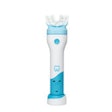An ultrasonic oral irrigator may reduce gingival inflammation more effectively than using dental floss as an adjunct to manual toothbrushing, according to a study recently published in the International Journal of Dental Hygiene.
Not only did the irrigator appear to reduce gum inflammation, but patients also liked how easy it was to use, the authors wrote.
"Those participants who used water irrigation experienced greater benefits in terms of reduced gingival inflammation (whether measured by gingival index or bleeding on marginal probing [BOMP]) than those using dental floss after 4 weeks," wrote the authors, led by Susan M. Bissett of the Newcastle University School of Dental Sciences in the U.K. (Int J Dent Hyg, November 29, 2024).
Ultrasonic oral irrigators use fine bubbles and ultrasonic shock waves to remove plaque. These devices have demonstrated effectiveness in lab tests, but they have not yet been clinically evaluated. This study aimed to compare its effectiveness, alongside toothbrushing, to dental floss in reducing gingival inflammation in patients with gingivitis, they wrote.
This single-center, randomized, single-blind study was conducted from May 8 to June 30, 2023. A total of 62 participants, with an average age of approximately 42, were randomized. The test group used the ultrasonic oral irrigator once daily in the evening after brushing. Participants also completed a self-assessment questionnaire.
Mean gingival index (GI) scores significantly decreased in both the ultrasonic irrigator and manual floss groups after one and four weeks (p < 0.01). By week four, the ultrasonic irrigator showed a greater reduction in GI scores (mean difference, -0.35 ± 0.26) compared to manual floss (-0.16 ± 0.25) (p < 0.01), they wrote.
Both groups showed significant reductions in the total plaque index (PI) and marginal PI at weeks one and four (p < 0.05), with no differences between groups at either time point. Proximal PI scores decreased significantly after week one (p < 0.05) with no difference between groups, and by week four, there were no significant differences compared to baseline.
BOMP reduced significantly in both groups at weeks one and four (p < 0.001). At week four, the ultrasonic irrigator showed a significantly greater reduction in BOMP (-0.26 ± 0.12) compared to manual floss (-0.15 ± 0.15) (p < 0.01). Probing pocket depths (PPDs) significantly decreased in both groups after four weeks (p < 0.05) but not at week one, with no differences between groups at either time point, they wrote.
Additionally, ease-of-use ratings revealed that significantly more participants found the ultrasonic irrigator easy to use (90%, n = 28) compared to manual floss (68%, n = 21) (chi-squared = 4.77, p < 0.05).
However, the study's short four-week duration is a limitation, as low-certainty evidence suggests oral irrigators may reduce gingivitis at one month but not at three or six months, the authors wrote.
"Our study revealed a high level of satisfaction with the ultrasonic irrigator device as compared to floss, with high scores regarding ease of use, being pleasant to use and gentle on the gums, reaching difficult areas and making the mouth feel fresh and clean,” Bissett colleagues wrote.




















